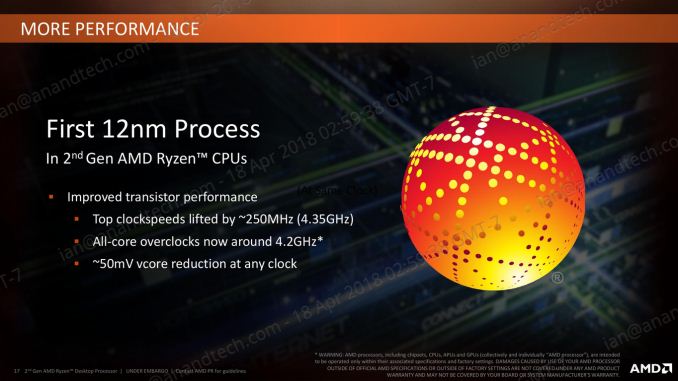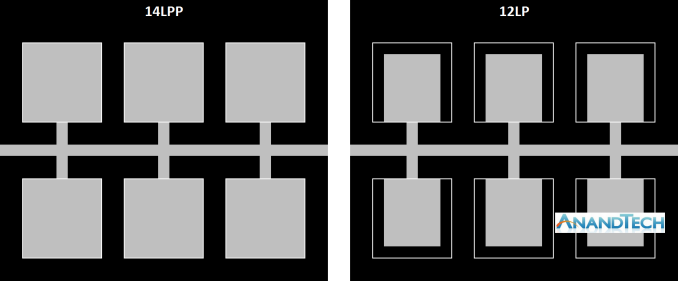The AMD 2nd Gen Ryzen Deep Dive: The 2700X, 2700, 2600X, and 2600 Tested
by Ian Cutress on April 19, 2018 9:00 AM ESTTalking 12nm and Zen+
One of the highlights of the Ryzen 2000-series launch is that these processors use GlobalFoundries’ 12LP manufacturing process, compared to the 14LPP process used for the first generation of Ryzen processors. Both AMD and GlobalFoundries have discussed the differences in the processes, however it is worth understanding that each company has different goals: AMD only needs to promote what helps its products, whereas GlobalFoundries is a semiconductor foundry with many clients and might promote ideal-scenario numbers. Earlier this year we were invited to GlobalFoundries Fab 8 in upstate New York to visit the clean room, and had a chance to interview Dr. Gary Patton, the CTO.
The Future of Silicon: An Exclusive Interview with Dr. Gary Patton, CTO of GlobalFoundries
In that interview, several interesting items came to light. First, that the CTO doesn’t necessarily have to care much about what certain processes are called: their customers know the performance of a given process regardless of the advertised ‘nm’ number based on the development tools given to them. Second, that 12LP is a series of minor tweaks to 14LPP, relating to performance bumps and improvements that come from a partial optical shrink and a slight change in manufacturing rules in the middle-line and back-end of the manufacturing process. In the past this might not have been so news worthy, however GF’s customers want to take advantage of the improved process.
Overall, GlobalFoundries has stated that its 12LP process offers a 10% performance improvement and a 15% circuit density improvement over 14LPP.
This has been interpreted in many ways, such as an extra 10% frequency at the same power, or lower power for the same frequency, and an opportunity to build smaller chips.
As part of today’s launch, AMD has clarified what the move to 12LP has meant for the Ryzen 2000-series:
- Top Clock Speeds lifted by ~250 MHz (~6%)
- All-core overclocks around 4.2 GHz
- ~50 mV core voltage reduction
AMD goes on to explain that at the same frequency, its new Ryzen 2000-series processors draw around 11% less power than the Ryzen 1000-series. The claims also state that this translates to +16% performance at the same power. These claims are a little muddled, as AMD has other new technologies in the 2000-series which will affect performance as well.
One interesting element is that although GF claims that there is a 15% density improvement, AMD is stating that these processors have the same die size and transistor count as the previous generation. Ultimately this seems in opposition to common sense – surely AMD would want to use smaller dies to get more chips per wafer?
Ultimately, the new processors are almost carbon copies of the old ones, both in terms of design and microarchitecture. AMD is calling the design of the cores as ‘Zen+’ to differentiate them to the previous generation ‘Zen’ design, and it mostly comes down to how the microarchitecture features are laid out on the silicon. When discussing with AMD, the best way to explain it is that some of the design of the key features has not moved – they just take up less area, leaving more dark silicon between other features.
Here is a very crude representation of features attached to a data path. On the left is the 14LPP design, and each of the six features has a specific size and connects to the bus. Between each of the features is the dark silicon – unused silicon that is either seen as useless, or can be used as a thermal buffer between high-energy parts. On the right is the representation of the 12LP design – each of the features have been reduced in size, putting more dark silicon between themselves (the white boxes show the original size of the feature). In this context, the number of transistors is the same, and the die size is the same. But if anything in the design was thermally limited by the close proximity of two features, there is now more distance between them such that they should interfere with each other less.
For reference, AMD lists the die-size of these new parts as 213mm2, containing 4.8 billion transistors, identical to the first generation silicon design. AMD confirmed that they are using 9T transistor libraries, also the same as the previous generation, although GlobalFoundries offers a 7.5T design as well.
So is Zen+ a New Microarchitecture, or Process Node Change?
Ultimately, nothing about most of the Zen+ physical design layout is new. Aside from the manufacturing process node change and likely minor adjustments, the rest of the adjustments are in firmware and support:
- Cache latency adjustments leading to +3% IPC
- Increased DRAM Frequency Support to DDR4-2933
- Better voltage/frequency curves, leading to +10% performance overall
- Better Boost Performance with Precision Boost 2
- Better Thermal Response with XFR2













545 Comments
View All Comments
Ananke - Thursday, April 19, 2018 - link
Intel is making in the ballpark of 90+% gross profit on high end desktop processors and server chips. AMD's cost scale is at least twice worse, hence they need VOLUME mostly, to make better profits and to establish themselves, and they simply cannot charge more than Intel for similar performance, worse track record and higher business risk - if you are a system integrator /Dell, HP/ or large corporate buyer /Chase Bank for example/ , you don't want to buy billions of $ inventory from non rock solid business with decades of consistent tech support etc, unless price is like triple difference...So in essence, if AMD can get away with this high pricing, they will be very lucky.
jjj - Thursday, April 19, 2018 - link
Gaming results are odd in the 8700k and 8400 review too, maybe some script that automates the process went sideways?Compare this review to the 8700k review in Civ6 for the 8700k or look how he 8400 tops the charts at times.
Singuy888 - Thursday, April 19, 2018 - link
Stop focusing on if Anandtech destroyed Coffee Lake's performance. They didn't. Look back at their coffee lake review and all the game numbers are the same. The real question is, how did they get Ryzen to perform so well!Anandtech's Coffee lake review and they used a gtx 1080 with similar games. Here are the results for a 8700k.
Coffee Lake Review:
GTA V: 90.14
ROTR: 100.45
Shadow of Mordor. 152.57
Ryzen 2nd Gen Review Post Patch
GTA5: 91.77
ROTR: 103.63
Shadow of Mordor: 153.85
Post patch Intel chip actually shows improved performance so this is not about other reviewers not patching their processors but how did Anandtech get such kickass results with Ryzen 2nd Gen.
Hxx - Thursday, April 19, 2018 - link
8700k is clearly the better chip for gaming because of the better clocks. As simple as that. Ryzen 2 just closed the gap a little more from Ryzen 1. For multithreaded workloads, Ryzen 2 is likely the better buy which also makes sense because of the 2 extra cores. So same as before except now the gap between those chips is much smaller. From a price point though, Intel has the better pricing . The 8700k has been as low as $280 so ultimately depends on pricing but if both chips were the exact same price and the board were the exact same price then i would buy based on your use case....productivity vs gaming.Singuy888 - Thursday, April 19, 2018 - link
I'm looking at 344 for the 8700K. That doesn't look like it's cheaper to me, especially I'll have to drop another 50 bucks for a cooler. Also there are very few specific use cases for a 8700k in the gaming department. It's actually pretty hard to think of any since a 2700k will be just fine if you have a 144hz monitor. Perhaps there is that one game that's just falling below your target frame rate but for any esport games with a 1080ti, both processors are giving you way beyond what you need.Losing about 30% in productivity tasks on the hand is more devastating than losing 5-10% frames from 200 vs 189...all that for almost 100 dollars more with zero upgrade path either.
TheJian - Thursday, April 19, 2018 - link
Agree with most of that (raise your hand if you have a 144hz monitor...Not many), but don't forget you get a gpu for free out of Intel (well, it costs more, not free I guess...LOL). I just had to use my 4790k's gpu for a while to RMA my Radeon. I was surprised by how good it was for my usage sans most gaming and even then I just went gog older games for a bit.Handbrake is ludicrously fast with Intel's gpu also. Quality is pretty darn good if you add some settings for instance:
option1=value1:option2=value2:tu=1:ref=4
There are more, just what I used with 4790k. I can't wait to try the 8700k if I don't go AMD. Unfortunately cuda isn't supported yet in handbrake so my 1070ti didn't do squat for that (boggles my mind, cuda is in 70-80% of the desktops out there today).
I'm looking at $346 for 8700k, but the heatsink will only be $30 (evo212 same as my 4790k) as I'm just going to buy another of the same for this build unless I go AMD. So $375 vs. 330. I don't think you'll be able to upgrade to 12 core on the same socket (only thing worth it from a 2700x IMHO, a few speeds bumps aren't worth squat), so not sure I'm gaining anything either way. I buy at or near top these days for the board bought (whatever is $350 or so I guess) and replace cpu/moboard/mem in most cases for the entire family the last 10yrs or so. I used to upgrade more, but today there are usually more reasons to dump it all than to keep it. I just give it to some other family member much like business does to employees who don't need top end stuff (they always love it, IE, dad getting 4790k shortly).
msroadkill612 - Friday, April 20, 2018 - link
Where desktops are hitting a wall mainly is system memory speed and IO lanes.Only threadripper platform really takes you to the next level.
I dont believe TR has to wait for 7nm to be spectacular - the Zen+ treatment will do that in 2H 2018.
msroadkill612 - Friday, April 20, 2018 - link
"Losing about 30% in productivity tasks on the hand is more devastating than losing 5-10% frames"Yes, except it can be even more extreme, yet reviewers annoyingly seem to give vastly disproportionate coverage to a few fps gain fora frivolity, to a major edge in areas that put bread on the table.
Nobody is going to buy a pc for work and another for gaming when one would do both, but work is first priority when choosing a rig.
lfred - Thursday, April 19, 2018 - link
Yep spot on... kickass result and really low power usage compare to other review where Ryzen2 on the power hungry side.. One hypothesis is the Motherboard, from what is suggested in other review (gamersnexus.net) the way MB maker implemented the new differents 'turbo' feature and auto memory timing adjustment seems to change from one Manufacturer to and other.. That's an hypothesis maybe its wrongboozed - Thursday, April 19, 2018 - link
AMD's on a roll. This is good.Having read the comments... I am really surprised that you still allow comments.